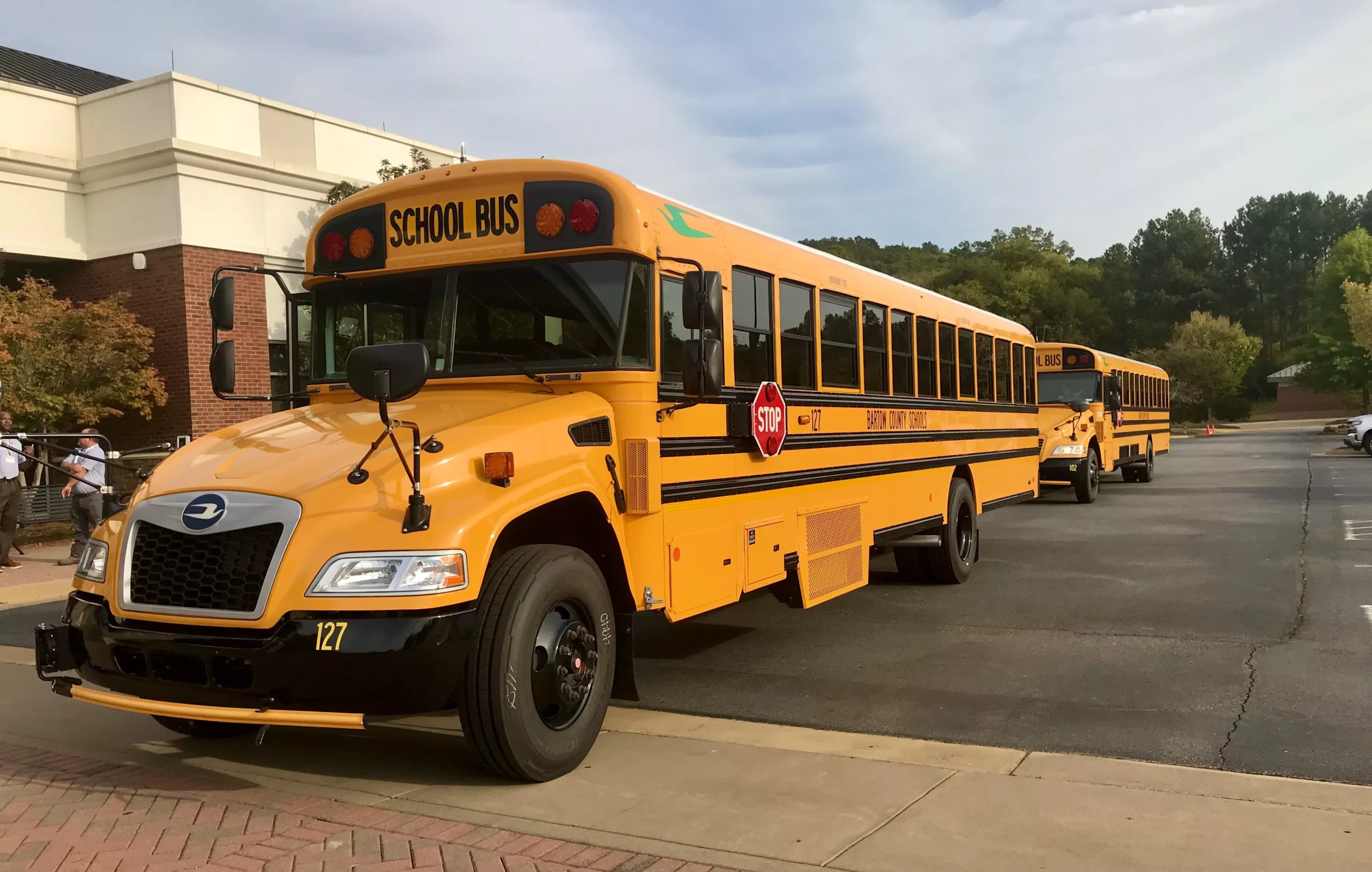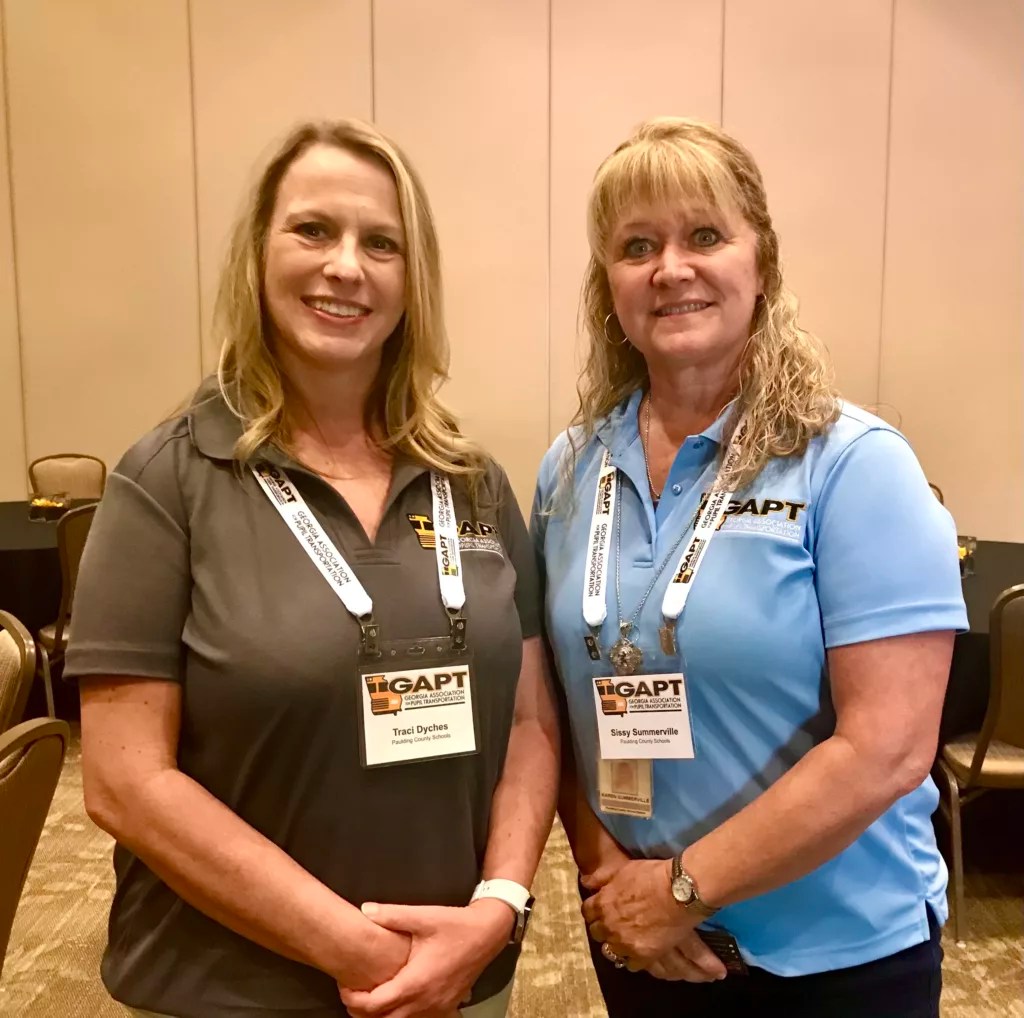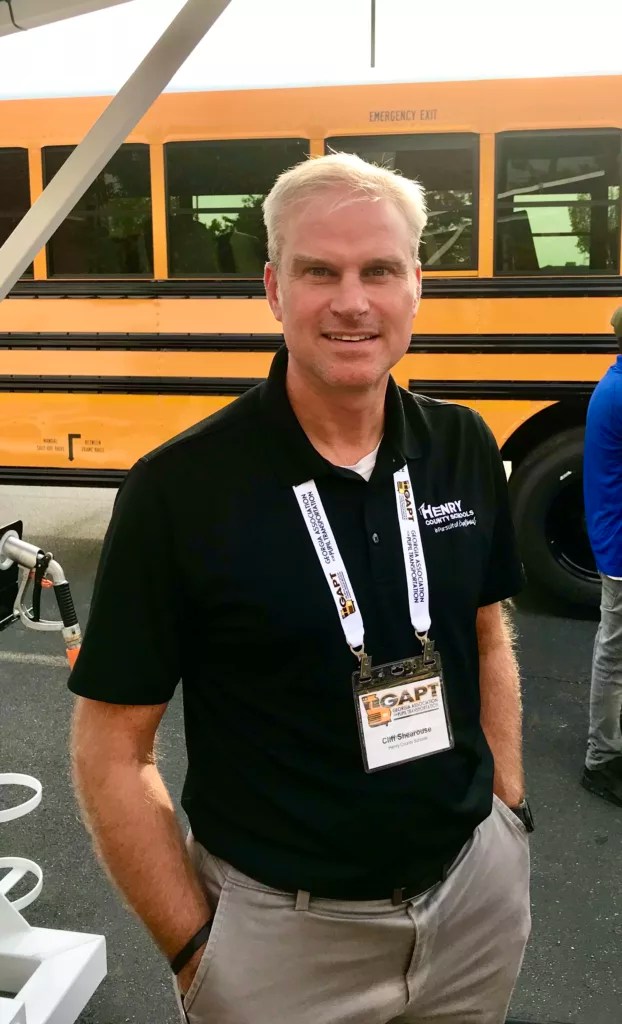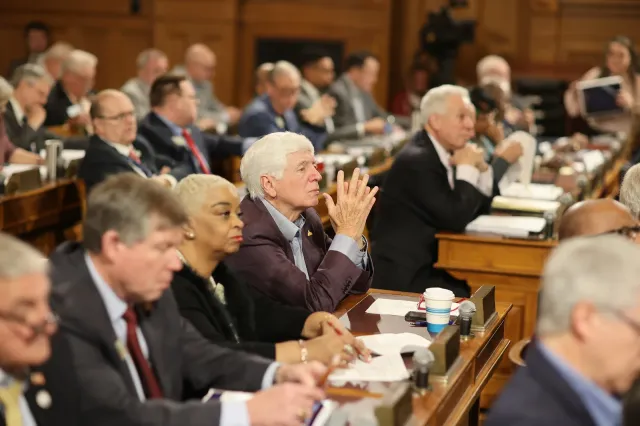Stay ahead of the curve as a political insider with deep policy analysis, daily briefings and policy-shaping tools.
Request a DemoSchool districts turn to bus monitors to address chronic driver shortage

Some school districts in Georgia are turning to bus monitors to keep students safe, and drivers less stressed. (Credit: Jill Jordan Sieder)
This story is part of an ongoing investigation that looks at the state’s aging school buses and bus driver shortages — a combination that is having a significant impact on the education of Georgia’s youth.

The Gist
ATLANTA — Some Georgia school districts whose bus operations are hampered by driver vacancies are now using bus monitors to help maintain order and safety on buses — and as a driver retention strategy.
What’s Happening
As school districts look for ways to address the statewide bus driver shortage and related challenges — including bus overcrowding, fighting and behavioral issues on buses, as well as student tardiness — some districts are turning to bus monitors as a solution.
Bus monitors are required on all Georgia school buses that transport students with special needs, including physical and mental challenges. They help students with mobility issues on and off the bus, buckle them into seatbelts, de-escalate conflicts and allow the driver to focus on the road.
Now some school districts are deploying monitors on what schools refer to as regular education routes, which typically don’t have another adult besides the driver onboard.
About half of Paulding County Schools’ 104 bus monitors are now assigned to “regular ed” bus routes, Assistant Transportation Director Traci Dyches said.

These monitors are deployed on bus routes that have the most students and those which tend to have students with behavioral issues, Dyches said. The monitors are helping to reduce fighting among students, as well as “to make sure they’re staying in their seats and not being thrown around the bus,” she said.
“The drivers are really liking the additional help,” said Sissy Summerville, another assistant transportation director for Paulding. “It kind of helps them with multitasking, to where they’re not keeping their eyes in the mirror the whole time and are more able to focus on the safety of the driving, while the other adult on the bus is able to focus more on the students.”
Such help could have come in handy earlier this year, when a substitute driver for Paulding was slapped by a parent, and other parents pulled students from the back of the bus at a busy intersection amid a tense altercation between the driver and a group of parents, captured on a video that went viral.
Marietta City Schools Transportation Director Kim Ellis said her district started using bus monitors last year on regular education routes and now has five monitors who float among the routes where drivers most need support.
“If you have students who are being disruptive … they’ve been in a very controlled atmosphere in a classroom for most of the day, the bell rings, and they mass exodus from the school; they’re wound up, and you put 60 of those kids and you’ve got one adult on the bus. You know, we don’t put 60 kids in one classroom, but we will on a bus. That’s a lot for a driver whose primary focus should be operating that vehicle,” Ellis said. “So whenever we have an extra monitor, it’s just a great asset for that driver and those students.”
Why It Matters
Bus drivers say managing bad student behavior is one of the hardest parts of the job, and it’s why many of them quit.
“Driver retention is all based on student behavior,” said Cliff Shearouse, executive director of transportation for Henry County Schools. “Most of the time drivers leave it’s because of student discipline issues, so if we can get a monitor on the bus, the partnership that the driver then has with that monitor is huge … and it helps us retain those drivers,” he said.

Henry County raised the pay of all its bus drivers by $2 an hour this year, to a starting wage of $19.79. But the district is still short 60 of the 300 bus drivers it needs for daily bus routes, which means that many drivers are doing double routes, some buses are crowded, and many students arrive at school late, Shearouse said.
Henry County can’t afford to hire bus monitors, he said, but the school district is paying teachers, paraprofessionals and other school staff to ride elementary and middle school buses and serve as monitors, covering about 30% of their daily routes. Shearouse said they put staff on “the problem buses — those with either the most students or those with the most discipline issues.”
“We’re finding similar results. Compensation isn’t everything,” said John Franklin, senior executive director of transportation for Atlanta Public Schools, noting that exit surveys of the city’s school bus drivers “often point towards student behavior and a perceived lack of help” from school administrators as their main reason for leaving. Atlanta Public Schools use bus monitors only on special education routes.
“My goal is to have a monitor on every bus,” said Tracy Barnes, transportation director for Ben Hill County Schools. As a former school principal, she said, “I know about discipline issues … and the bus driver is the No. 1 important factor to keep that bus safe. Having another pair of eyes on the bus makes their job so much easier.”
Ben Hill County Schools currently has 45 buses and only 28 drivers, which means that Barnes and her three mechanics regularly have to drive buses in addition to their other duties. She said the district’s part-time bus monitors, who are paid $12 an hour, are helping her to retain the drivers she has.
What’s Next
Two bills related to school transportation funding introduced in the 2023 session are still pending in the Legislature’s two-year cycle.
Rep. Roger Bruce, D-Atlanta, introduced HB 238, which would fund a five-year pilot program to provide $3 million in annual funding for bus monitors to school districts that demonstrate the greatest need for them. It also directs the state board of education to assess the impact of bus monitors on student conduct, bus safety and bus driver retention.
The bill was prompted by outcry from middle-school students in Fulton County, who reported fighting and unsafe conditions on overcrowded buses. The students, who helped to write the bill, testified before the House education committee last March. Several legislators expressed concern about the troublesome bus conditions they described, but didn’t vote on the bill.
HB 712, aimed at increasing the state’s contribution towards school transportation funding, which has substantially diminished over the last 20 years, is also awaiting action in the education committee.
Read these related stories:
Have questions, comments or tips? Contact Jill Jordan Sieder on X @journalistajill or at [email protected].
Facebook @STATEAFFAIRSGA
Instagram@STATEAFFAIRSGA
LinkedIn @STATEAFFAIRS
Header photo: Some school districts in Georgia are turning to bus monitors to keep students safe, and drivers less stressed. (Credit: Jill Jordan Sieder)
Busing Breakdown Logo: (Credit: Brittney Phan)
Gov. Kemp calls on state agencies to be fiscally restrained amid record $16.5B surplus
The Gist Gov. Brian Kemp asked the state’s 51 government agencies for continued fiscal restraint when drafting their amended fiscal year 2025 and 2026 budgets. Most agencies adhered to his request even as the state’s general fund surplus hit a record $16.5 billion last month. Forty-five agencies, excluding state courts, followed the governor’s instructions to …
Georgia defies bomb threats as election chief declares a “free, fair and fast” vote amid record turnout
ATLANTA – Despite dealing with over 60 bomb threats, Georgia’s election chief said Tuesday the state’s general election went smoothly. Georgia had a record turnout with nearly 5.3 million people voting, Secretary of State Brad Raffensperger told reporters. Election officials in the state’s 159 counties have until 5 p.m. to certify votes. “We had a …
In the (state)house: Meet the newest members of the Georgia legislature
When lawmakers reconvene at the state Capitol on Jan. 13, there’ll be a cadre of new faces in the 236-member Georgia General Assembly, one of the nation’s largest state legislatures. All 236 statehouse seats were up for election this year. Most candidates ran unopposed. Incumbents in contested races easily kept their seats, with the exception …
2 young Democrats win Statehouse seats as Republicans hold majority
ATLANTA — Many Statehouse incumbents appeared to beat back challengers Tuesday, ensuring their return to the Capitol in January. Republicans retain control of the House and Senate. Two Generation Z candidates will join the 236-member Legislature as new members of the House of Representatives: Democrats Bryce Berry and Gabriel Sanchez. Berry, a 22-year-old Atlanta middle …




